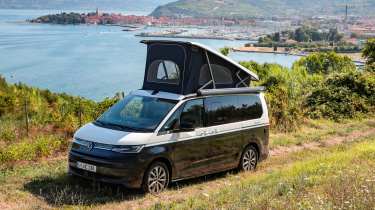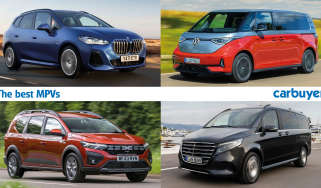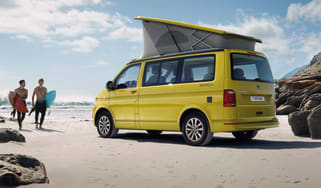Volkswagen California review – the class-leading camper, despite its flaws
“The Volkswagen California is the class-leading campervan, but in some ways it’s less usable than before”
Pros
- Well built
- Interior feels spacious and airy
- Good to drive
Cons
- Second sliding door affects usability
- Lack of storage space
- Expensive
Verdict – is the Volkswagen California a good car?
The Volkswagen California successfully defends its title as the king of camping and feels more modern than before. It feels more car-like to drive than ever thanks to Volkswagen Golf underpinnings. We don’t like some of the interior controls carried over from that hatchback, though, and the choice to add a second sliding door has had a detrimental effect on the interior layout and storage space, which has impacted the California’s usability.
Volkswagen California models, specs and alternatives
The Volkswagen California is a campervan based on the brand’s MPV, the Volkswagen Multivan. VW has a rich heritage of offering campervans, most famously with the original Volkswagen T1, but the original Volkswagen California name has been in use since around 2003, with the recipe having become more and more polished with every iteration.
The California has a few rivals to contend with these days, including the Ford Transit Custom Nugget and the Citroen Holidays, both cars which build on the underpinnings of van-based MPVs in their respective brands’ lineups.
The fact that Volkswagen has chosen to base the California around the Multivan – a car designed from the outset as an MPV which does not have commercial underpinnings – should mean it’s more refined and car-like than ever before.
More reviews
Car trim reviews
In-depth reviews
- Abarth 600e review – a feisty electric SUV with some drawbacks
- Abarth 500e review - the most fun small EV?
- Abarth 595 hatchback review
- Abarth 500 hatchback (2008-2016)
- Abarth 124 Spider convertible (2017-2019)
Road tests
Used car reviews
The Multivan’s exterior design is a lot more modern to look at than the MPVs that came before it, and that’s obviously carried over to the California. The headlights and front grille take some styling cues from VW’s ID. range of electric vehicles and unlike the van-based California that came before it, there’s more rake to the windscreen and front quarter glass on the front pillars to increase visibility and give an airier feel to the cabin.
Under the skin, the Volkswagen California is powered by fairly conventional engines from launch. There’s a 2.0-litre TDI diesel with 148bhp; the sort of engine that’s long been a staple of motorhomes given its ability to haul around the added weight of the furnishings inside and potentially haul a trailer behind as well. Less conventionally, there’s also the option of a 201bhp 2.0-litre petrol TSI engine, but it won’t be quite as good on fuel and is less well suited for the sort of long-distance drives that a diesel engine is good for.
Volkswagen says a plug-in hybrid version will also join the range later with a range of up to 60 miles possible on electricity alone, which means you’ll be able to pull up to the campsite in near silence without disturbing all the other campers, and fuel economy should be good so long as it’s kept charged up frequently.
Practicality is a focus as you’d expect – Volkswagen has kept sliding doors for both sides on the California, but this does have the drawback of limiting the size of the kitchenette. The cabin is also kitted out with the latest camping equipment, two sleeping areas and lots of thought has gone into storage too, and things like the removable sliding chairs mean the car can double as a van when you need it to.
The range is available in three versions: Beach, Coast and Ocean. Even the most basic Beach model comes with most of the equipment campers will need for a trip, with stuff like a pull-out hob in the boot making it more versatile than a conventional overnight sleeper. The Coast is a happy middle ground, and brings a full kitchenette and other niceties to improve the overall experience, while Ocean gets a more upmarket finish and upholstery and convenience features such as an electric tailgate and powered sliding doors as well as heated seats.
|
Trim levels |
Power options |
|
|
MPG, running costs & CO2 emissions
Diesel engines have long been a mainstay of the campervan market thanks to their ability to return impressive fuel economy over longer distances, and the pulling power they offer being well suited to the extra weight associated with a camper. It comes as no surprise, then, that the Volkswagen California is offered with a 2.0-litre TDI diesel engine. This model returns fuel economy in the low 40s, which isn’t terrible considering the size and weight of the California. CO2 emissions are fairly high at 177g/km.
The California is also offered with a 2.0-litre TSI turbocharged petrol engine, but it’s likely to be a lot worse on fuel, while official figures are yet to be released for this model.
A plug-in hybrid will join the range later, but this is quoted with a range of up to 62 miles on electricity, so we’d expect it to be very cheap to run so long as it’s regularly charged up. If you can’t keep it charged up regularly and don’t have a home wallbox charger, it might not be worth the extra initial cost as the diesel should be well suited for long distance driving in any case, but check how you’re going to use it before you buy.
|
Model |
Fuel economy |
CO2 emissions |
|
2.0-litre TDI 148bhp |
42.2mpg |
177g/km |
|
2.0-litre TSI 201bhp |
TBC |
TBC |
|
1.5-litre 242bhp plug-in eHybrid |
TBC |
TBC |
How much will the Volkswagen California cost in tax?
The Volkswagen California in diesel and petrol guise will cost the standard annual £190 rate in VED (road tax), while the plug-in hybrid should be eligible for the £10 discount as an alternative fuel vehicle. However, because the California is expensive and costs over £40,000, all models will incur the luxury vehicle surcharge which is an extra annual payment of £410 from years two to six of the car’s life.
What will the Volkswagen California cost to insure?
Insurance groups for the Volkswagen California are yet to be confirmed, but for context the old model sat between groups 26 to 32 out of 50.
Engines, drive & performance
The Volkswagen California launches with a conventional choice of diesel and petrol engines, but a flagship plug-in hybrid will arrive later on for some extra versatility and electric-only driving.
We’ve so far driven the diesel version and found it refined and comfortable to ride in. The occasional pothole or road imperfection can upset the California somewhat, with the entire car shaking upon impact, but this is mostly down to the fact that the hole for the pop-up roof diminishes some of the rigidity of the motorhome’s structure.
The Multivan on which the California is based is built on the same underpinnings as the Volkswagen Golf, rather than an existing commercial van like the old model is based on. When we drove the Multivan, we thought it felt surprisingly agile for a car of its size, with responsive and light steering.
Petrol models
We’re yet to try the Volkswagen California fitted with the 2.0-litre TSI petrol engine, but we have driven it in the Multivan. We have to admit that it feels like the least suited to its application in the Multivan because it has to work hard to haul around the MPV’s heavy weight, which doesn’t spell good news for the even-heavier Volkswagen California. We’d stick to the diesel if it was our money.
|
Model |
Power |
0-62mph |
Top speed |
|
2.0-litre TSI |
201bhp |
TBC |
TBC |
Diesel models
The 2.0-litre TDI diesel feels right for the Volkswagen California with plenty of pulling power that suits a car of this size and weight. Diesels are better for long-distance driving, and with the adventurous nature of a campervan, it’s likely this is the sort of driving that will be done with it for the majority of the time.
|
Model |
Power |
0-62mph |
Top speed |
|
2.0-litre TDI |
148bhp |
TBC |
117mph |
Plug-in hybrid models
Volkswagen is releasing a plug-in hybrid version of the Volkswagen California in 2025. While we still think the diesel makes the most sense, there’s some appeal in the ability of doing shorter trips on electricity alone. There’s also some appeal in the possibility of pulling up to the campsite quietly thanks to the electric motors, especially if it’s late and you don’t want to bother your neighbours. You’ll only really be able to make the most of this as long as it’s regularly charged – it could come in useful if you’re able to charge on-site at a campsite and want to save fuel on closer runs nearby to pick up supplies at a shop, for example.
|
Model |
Power |
0-62mph |
Top speed |
|
1.5-litre eHybrid |
242bhp |
TBC |
TBC |
Interior & comfort
As with the Volkswagen Multivan, the Volkswagen California’s interior feels well built and more modern than the previous-generation car. Many of the features on the dash are taken from the Volkswagen Golf and Passat which means there’s some upmarket appeal and it gives a solid, sturdy impression.
The California’s upholstery feels hard-wearing, and though our test car’s fabrics were dark in colour, the interior still felt airy and bright.
However, it’s frustrating to see the touch-slider buttons have been carried over from the Mk8 Golf, as these have been a bugbear for many users and have been upgraded in the facelifted version of the hatchback since. They are fiddly to use and lack backlighting, making them hard to use at night.
There’s a useful touch panel on the California’s C-pillar which shows readouts of the campervan’s vital stats, such as fresh and waste water levels, lighting and battery level. A few functions can also be accessed here, such as to toggle the fridge on and off, as well as enabling a ‘camping mode’ which stops the headlights coming on if you lock or unlock the vehicle – useful if you’re wandering out in the middle of the night and don’t want to disturb other campers nearby. Our only gripe is that the touch panel suffers from a lot of lag which can make it frustrating to use, and all the same functions can already be accessed from a smartphone app.
Is the Volkswagen California’s infotainment and sat-nav system easy to use?
The Volkswagen California gets the same infotainment system as that used in the Mk8 Golf, meaning it features a 10-inch touchscreen. It’s not the best system and it would be great to see the improved infotainment make it to the California, because the menu layouts can be hard to navigate and the touch-sensitive slider can be frustrating to use.
Key features | |
|
Beach
|
Coast (Beach plus…)
|
|
Ocean (Coast plus…)
| |
Boot space, practicality & dimensions
A campervan like the Volkswagen California is all about usability – not necessarily for the day-to-day, but certainly for fun camping trips and adventures. Just like the Multivan, the front seats can swivel 180 degrees to face the rest of the cabin, which makes the space feel much more livable and airy.
There are storage compartments under the kitchenette’s sink as well as a pull-out fridge and single-ring gas hob. That’s actually one less than the old California had, but Volkswagen says that very few owners would cook inside their vans given that there’s an external-facing plug and removable table that allows campers to cook meals outside under the awning, meaning cooking smells don’t stay inside the California.
Now there are two sliding doors – one on each side of the California – but during our time camping in it we hardly used the left side. Volkswagen actually says it chose to keep the second door to make the California more capable of day-to-day usability outside of camping – we would argue it’s much better to have just one sliding door and extend the length of the kitchenette for improved usability and storage for its main camping duties. Rather than one bench for rear seats with a large pull-out draw underneath for storage, the California now gets three separate sliding rear seats, meaning that the space is compromised with smaller drawers.
There are at least some drop-down bins for keeping clothes or bags, storage space underneath the bed at the back and a further cupboard. One of the side rear windows also gets a zip-up bag to keep other items in. We’d say storage space is just about adequate for a week away.
The California features two distinct bed spaces. There’s the rear bed which is formed by folding down the rear seats, and the roof pops up to reveal a second bed space. On Coast and Ocean models this can be done electronically. The rear bed space is harder to set up and we found it to be decidedly less comfortable. Once set up the majority of the space in the cabin is inaccessible, so it makes sense to sleep in the top compartment if camping alone or as a couple.
|
Size comparison | |||
|
Model |
Length |
Width |
Height |
|
Volkswagen California |
5,173mm |
1,941mm |
1,972mm |
|
Ford Transit Custom Nugget |
4,972mm |
1,979mm |
2,060mm |
Reliability & safety
Volkswagen doesn’t perform particularly well in our Driver Power customer satisfaction surveys. The brand came in 29th place out of 32 manufacturers in 2024, which makes it dead last out of all the other Volkswagen Group brands. The California itself did not feature, nor did the Multivan MPV on which it’s based, but the closest manufacturer to offer a rival campervan is Ford, which placed one behind Volkswagen in 30th place for customer satisfaction.
Volkswagen reliability is nothing to write home about, and a fairly average 23% of VW owners reported an issue with their car in the first year. Ford betters this, though, with just 20% of Ford owners reporting the same within the first year of ownership.
How safe is the Volkswagen California?
While the Volkswagen California has not been tested by Euro NCAP specifically, the Multivan on which it’s based was in 2022, getting a full five-star rating. It performed particularly well in the adult and child occupant protection categories, and it also scored highly for its safety assistance tech, but protection for vulnerable road users was its weakest score.
Should you buy a Volkswagen California?
If you’re an avid camper then there’s no denying the Volkswagen California is still the best choice in the compact campervan market, but there is a slight catch. We actually think the shorter kitchenette which has been designed so as to create an opening for an extra sliding door has made the California less useful and there’s much less storage space in the cabin than before.
While the goal for the extra sliding door has been to make the Volkswagen California more usable day-to-day when you’re not camping, it’s had a detrimental effect on the focus of the California as a motorhome, which seems like a misstep.
Aside from that, it’s much more modern than before, and the California’s car-derived underpinnings make it easy to drive and refined, even if some road imperfections can end up getting transmitted into the cabin.
All in all, the Volkswagen California does a good job of carrying on the brand’s legacy for creating adventure-ready campervans in the same spirit as the original surfer bus from the 1960s, while bringing the creature comforts you’d expect in 2024.
What is the Carbuyer pick of the Volkswagen California range?
While it may be fairly conventional, we reckon the diesel version makes the most sense for driving long distances. We’d spring for the mid-range Coast model as it brings the kitchenette and other useful features, rather than the sole pop-out hob in the boot on Beach trim.
Volkswagen California alternatives
There are few from-factory campervans on the market, but the Volkswagen California gets rivals by way of Ford’s Transit based camper and the upcoming Citroen Berlingo-based motorhome. Dacia also offers solutions such as its InNature sleep pack that can turn its Jogger MPV into an overnight sleeper – it’s a great value option if you don’t need all of the bells and whistles.
How we tested the Volkswagen California
We tested the Volkswagen California in Slovenia in August 2024 for two nights covering 300 miles between town, motorway, mountain passes and some unpaved roads.



























